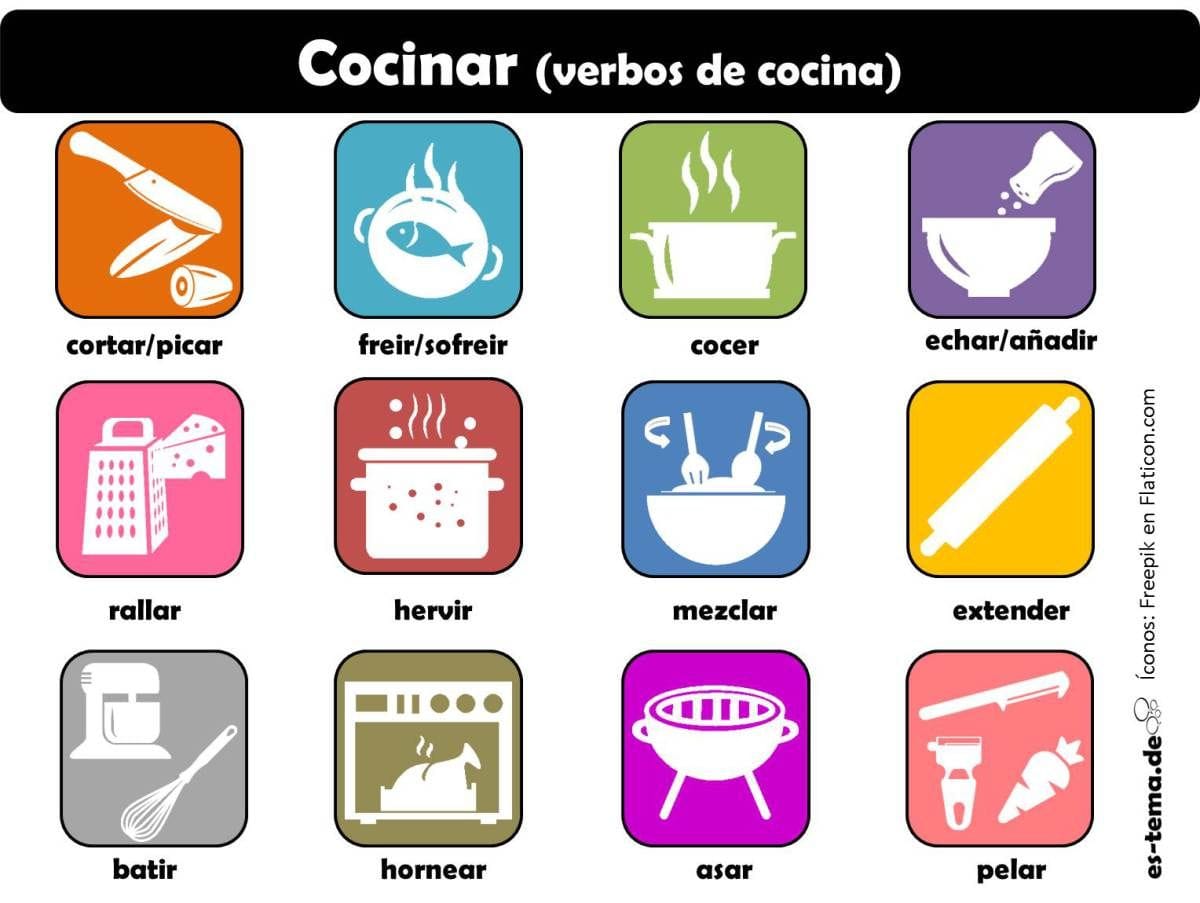This guide will transform you from a Spanish cooking novice to a culinary communication expert. We’ll explore the verb cocinar (to cook) in all its forms, providing you with the recipe for Spanish fluency in the kitchen and beyond. So, put on your metaphorical chef’s hat, and let’s get cooking!
Cocinar: A Regular Verb’s Recipe for Success
You want to talk about cooking in Spanish? Fantastic! Mastering cocinar is essential. Luckily, it’s a regular -AR verb, following predictable patterns like your favorite recipe. Once you learn the steps, you can apply them to other -AR verbs, expanding your culinary vocabulary quickly. The key is the stem “cocin-,” which remains consistent while the endings change based on the tense and pronoun.
Present Tense: What’s Cooking Ahora?
The present tense describes actions happening now. Imagine you’re giving a live cooking demonstration.
| Pronoun | Present Tense | Example |
|---|---|---|
| yo | cocino | Yo cocino paella todos los domingos. (I cook paella every Sunday.) |
| tú | cocinas | Tú cocinas muy bien. (You cook very well.) |
| él/ella/usted | cocina | Él cocina para su familia. (He cooks for his family.) |
| nosotros | cocinamos | Nosotros cocinamos juntos. (We cook together.) |
| vosotros | cocináis | Vosotros cocináis con mucho amor. (You guys cook with a lot of love.) |
| ellos/ellas/ustedes | cocinan | Ellos cocinan comida mexicana. (They cook Mexican food.) |
Past Tense: Cocinando in the Past
Let’s explore past culinary adventures using two tenses:
Preterite Tense: Completed Culinary Creations
The preterite tense describes completed past actions. Think about the delicious dish you made last night.
| Pronoun | Preterite Tense | Example |
|---|---|---|
| yo | cociné | Yo cociné un pastel ayer. (I cooked a cake yesterday.) |
| tú | cocinaste | Tú cocinaste una deliciosa cena. (You cooked a delicious dinner.) |
| él/ella/usted | cocinó | Ella cocinó para la fiesta. (She cooked for the party.) |
| nosotros | cocinamos | Nosotros cocinamos demasiado. (We cooked too much.) |
| vosotros | cocinasteis | Vosotros cocinasteis muy rápido. (You all cooked very quickly.) |
| ellos/ellas/ustedes | cocinaron | Ellos cocinaron para todos. (They cooked for everyone.) |
Imperfect Tense: Habitual Culinary Adventures
The imperfect tense describes habitual past actions. What did you use to cook growing up?
| Pronoun | Imperfect Tense | Example |
|---|---|---|
| yo | cocinaba | Yo cocinaba con mi abuela. (I used to cook with my grandmother.) |
| tú | cocinabas | Tú cocinabas todos los sábados. (You used to cook every Saturday.) |
| él/ella/usted | cocinaba | Él cocinaba para sus amigos. (He used to cook for his friends.) |
| nosotros | cocinábamos | Nosotros cocinábamos juntos cuando éramos niños. (We used to cook together when we were kids.) |
| vosotros | cocinabais | Vosotros cocinabais siempre pasta. (You all always used to cook pasta.) |
| ellos/ellas/ustedes | cocinaban | Ellos cocinaban comida italiana. (They used to cook Italian food.) |
Future Tense: Culinary Visions
What culinary delights will the future hold?
| Pronoun | Future Tense | Example |
|---|---|---|
| yo | cocinaré | Yo cocinaré pescado mañana. (I will cook fish tomorrow.) |
| tú | cocinarás | Tú cocinarás el postre. (You will cook the dessert.) |
| él/ella/usted | cocinará | Él cocinará para la cena. (He will cook for dinner.) |
| nosotros | cocinaremos | Nosotros cocinaremos una pizza. (We will cook a pizza.) |
| vosotros | cocinaréis | Vosotros cocinaréis la carne. (You all will cook the meat.) |
| ellos/ellas/ustedes | cocinarán | Ellos cocinarán para la familia. (They will cook for the family.) |
Beyond the Basics: Advanced Cocinar Techniques
There’s more to cocinar than meets the eye! We have the conditional tense (would cook), the subjunctive mood (for desires and possibilities related to cooking), and other forms like the gerund and participle. While these might seem daunting, they become second nature with practice. Don’t rush; gradually add new tenses as you progress.
Idiomatic Expressions: Cocinar Outside the Kitchen
Like English, cocinar has figurative uses. “Cocinar un plan” means to hatch a plan, perhaps suggesting something secretive is brewing. “Cocinar a fuego lento” translates to “simmer” or “take things slowly,” implying a careful and deliberate process. These idioms add depth to your Spanish and may vary regionally.
A Comprehensive Cocinar Conjugation Table
For a complete overview, here’s a table covering all the essential conjugations:
| Mood | Tense | Yo | Tú | Él/Ella/Usted | Nosotros | Vosotros | Ellos/Ellas/Ustedes |
|---|---|---|---|---|---|---|---|
| Indicative | Present | cocino | cocinas | cocina | cocinamos | cocináis | cocinan |
| Indicative | Preterite | cociné | cocinaste | cocinó | cocinamos | cocinasteis | cocinaron |
| Indicative | Imperfect | cocinaba | cocinabas | cocinaba | cocinábamos | cocinabais | cocinaban |
| Indicative | Future | cocinaré | cocinarás | cocinará | cocinaremos | cocinaréis | cocinarán |
| Indicative | Conditional | cocinaría | cocinarías | cocinaría | cocinaríamos | cocinaríais | cocinarían |
| Subjunctive | Present | cocine | cocines | cocine | cocinemos | cocinéis | cocinen |
| Subjunctive | Imperfect (1) | cocinara | cocinaras | cocinara | cocináramos | cocinarais | cocinaran |
| Subjunctive | Imperfect (2) | cocinase | cocinases | cocinase | cocinásemos | cocinaseis | cocinasen |
| Imperative | Affirmative | cocina | cocinad | – | – | – | – |
| Imperative | Negative | no cocines | no cocinéis | – | – | – | – |
Other Culinary Verbs
Expand your culinary vocabulary with verbs like freír (to fry), hornear (to bake), hervir (to boil), cortar (to cut), and asar (to roast), each with its own set of conjugations. Also, explore phrases like “¿Qué cocinas hoy?” (What are you cooking today?) or “Me gusta cocinar” (I like cooking).
Cultural Context: Cocinar and Hispanic Traditions
Cooking holds significant cultural weight in Spanish-speaking communities. Cocinar extends beyond mere food preparation; it represents family traditions, celebrations, and shared experiences. Regional variations exist, likely influencing vocabulary and techniques. Ongoing research likely continues to uncover these nuances.
Conclusion: Your Culinary Spanish Journey
Mastering cocinar is a significant step towards Spanish fluency. With practice and the resources here, you’ll soon be navigating culinary conversations with ease. Remember, language learning is a journey, and ongoing research suggests our understanding of these processes continues to grow. So, embrace the process, be patient, and enjoy exploring the rich world of Spanish! Advance your Spanish grammar skills and broaden your vocabulary by checking out caer Preterite and Cepillarse Conjugation.
- Unveiling Bernhard Caesar Einstein’s Scientific Achievements: A Legacy in Engineering - July 15, 2025
- Uncover who is Jerry McSorley: CEO, Family Man, Business Success Story - July 15, 2025
- Discover Bernhard Caesar Einstein’s Scientific Contributions: Unveiling a Legacy Beyond Einstein - July 15, 2025
















1 thought on “The Ultimate Guide to Cocinar Conjugation: From Beginner to Expert”
Comments are closed.